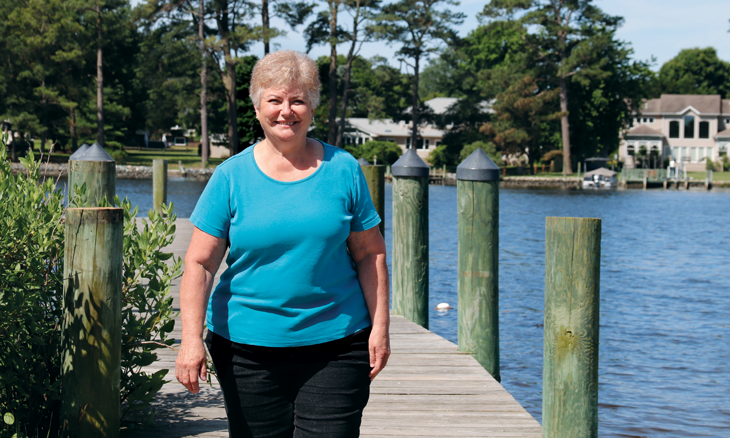
Ending the nag of knee pain
Following years of knee pain, Terry Gorlich decided it was time to consider surgery after she couldn’t even get her grocery shopping done in one trip. And she hasn’t looked back since. Gorlich’s motto: A good outlook leads to a good outcome.
Terry Gorlich is full of spunk. After spending nearly 40 years working for the state government in Dover, Delaware, she relocated to Lewes to enjoy retirement closer to some of her grandchildren. She’s spent her days making her new house a home and enjoying the local beach culture. But nagging knee pain was getting in the way of living her life to the fullest. That’s when she asked Bayhealth Orthopaedic Surgeon Stephen Manifold, MD, what she could do to alleviate the pain.
“I’ve been a patient with Dr. Manifold for years. When my knee pain first came on we treated it with medication, which worked for a while,” said Gorlich. “But I knew the pain was getting worse and I needed to do something about it.”
Gorlich remembers she finally had enough when she found herself going to the grocery store several times a week — she couldn’t finish a full trip in one visit because of the pain. There would be times when she would have to stop shopping because the pain was so unbearable.
“I remember it was a dramatic change for me when the pain was just too much,” said Gorlich. “I was active and then suddenly I couldn’t be. I mow my own grass, but then it was taking me three times as long. I loved to garden and then I felt like I couldn’t. I even used to do a boot camp group workout. I loved the atmosphere. But I definitely couldn’t do that anymore. That’s when I knew it was time for a change.”
Further tests confirmed the osteoarthritis in Gorlich’s knee had worsened. After another appointment with Dr. Manifold, they both decided Gorlich needed a total knee replacement. During a total knee replacement, an orthopaedic surgeon removes damaged cartilage and bone, and then positions the new implants to restore the alignment and function of the knee. Most patients who undergo a total knee replacement are able to reduce their pain while also improving their ability to do daily tasks again.
Gorlich had the surgery earlier this year at Bayhealth Milford Memorial. She started a physical therapy regimen a few weeks before the surgery and continued to go for several weeks after. She did both traditional physical therapy and aquatic therapy. She loved the aquatic therapy so much, she still goes several times a week as part of a maintenance program.
“One of the reasons Terry has done so well after surgery is her positive attitude and goal-oriented thinking,” said Dr. Manifold. “Terry knew what she needed to do to get the best outcome and she put in the work to achieve that. How a patient approaches that type of surgery is as important as the procedure itself in achieving a good outcome.”
“I was apprehensive at first — surgery is scary,” said Gorlich. “But I know my body. I knew I had to do something to get back the life I love. I credit so much of my success following my surgery to the physical therapy. It wasn’t always easy, but it made such a difference. I said from the beginning, a positive attitude leads to a positive outcome.”
Just weeks after her knee replacement surgery, Gorlich felt like her old self. She’s back to doing the things she loves, even planting flowers in her garden.
“I love having my life back. Now I can go downtown and shop or see friends. I can go to the grocery store without any trouble,” said Gorlich. “I’m mowing my grass again. I’ve even planted flowers in my garden. And I can’t wait to do even more in the garden next year. I did this for a better quality of life, and I’ve achieved it. It’s wonderful.”
Go to Bayhealth.org/Orthopaedics to learn more about the conditions we treat and treatment options.
When is it time to start thinking about a joint replacement?
- Once you require help for everyday routine tasks.
- When you feel like you can't take the pain anymore.
- When tests show significant joint damage.
- Once you've exhausted all nonsurgical options such as oral medications, injections, and therapy.
- When the pain interrupts your life and keeps you from the things you love.
If you’re experiencing these symptoms, speak to your doctor about your options.
